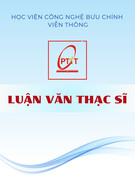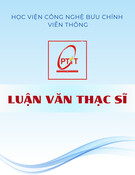
MINISTRY OF EDUCATION
AND TRAINING
MINISTRY OF AGRICULTURE AND
RURAL DEVELOPMENT
VIETNAM ACADEMY OF AGRICULTURAL SCIENCES
PHAM THI XUAN
STUDY ON SELECTION AND TECHNICAL MEASURES
TO IMPROVE WATERLOGGING ABILITY
OF WINTER SOYBEAN IN HANOI
Specialization: Crop Sciences
Code: 9620110
SUMMARY OF PhD THESIS
Hanoi - 2021

The thesis was completed at :
VIETNAM ACADEMY OF AGRICULTURAL SCIENCES
Supervisors:
1. Assoc. Prof. Dr. Tran Thi Truong
2. Dr. Tran Danh Suu
PhD thesis reviewer 1:
PhD thesis reviewer 2:
PhD thesis reviewer 3:
The thesis was reported to the Thesis Committee at the Institutional level in
Vietnam Academy of Agricultural Sciences
At h, date , month , 2022.
The thesis can be found at the libraries:
1. National Library of Vietnam
2. The Library of Vietnam Academy of Agricultural Sciences.

1
INTRODUCTION
1. Necessity of the study
Soybean or soya bean [Glycine max (L.) Merrill] belongs to the legume family
(Fabaceae), order Fabales. Soybean is one of the important crops of high economic
value with multiple uses, providing human feed, being a source of raw materials for
livestock, food industry, medicibe, cosmetics. In Vietnam, soybean is a long-standing
crop, having an important position in agricultural production and considered as a high
economic efficiency crop in the strategy of crop restructure, increasing the value of
agricultural products. With short growth duration, soybean can be cultivated in many
crop seasons during the year, being ideal in crop rotation, intercropping, increasing
of crop seasons and overlapping crop. Soybean production helps to increase land use
coefficient, create jobs and increase income for farmers.
The soybean planting area in Winter - Spring 2019 of Hanoi reached 2.9
thousand hectares over 3.4 thousand hectares planted for the whole year
(accounting for 85.3%); the yield was 1.69 tons/ha, the output reached 4.9
thousand tons out of 5.92 thousand tons/year (accounting for 83.05%). Soybean
has become the main crop, occupying an important position in the Winter crop
structure of Hanoi as well as the Red River Delta provinces.
However, the soybean production in Hanoi is still fragmented, dispersed, low
intensive investment, the application of new techniques is limited, and the
soybean production area is unstable and gradually shrinking. One of the main
reasons for low yield of soybeans is lack of collections of soybean varieties
suitable for the ecological conditions of Hanoi, as well as the appropriate and
synchronized technical measures.
Specifically, it usually rains around the end of September, at the beginning of
Winter soybean crop in Hanoi. The rain is prolonged and sometime heavy when
sowing soybean, the soil is always wet, the field can be flooded. Previously
selected soybean varieties were mostly drought and cold tolerant varieties;
research on flood-tolerant varieties has not been focused. Therefore, the selection
of soybean varieties that can be tolerant to waterlogging and adapted to the natural
conditions of Hanoi as well as identifying technical measures for Winter
soybeans soybeans on wet soil after rice harvesting to improve the yield and
efficiency of soybean production is necessary.
Based on the above mentioned necessity, we conducted the thesis: "Study on
selection and technical measures to improve waterlogging ability for Winter
soybean in Hanoi". The study on identification of soybean varieties tolerant to
waterlogging with farming conditions in Hanoi along with other technical
measures will contribute to improving the yield and output of soybeans in Hanoi,
and to raising incomes for farmers.
2. Objectives of the study
- Identifying soybean lines and varieties tolerant to waterlogging for the

2
development of Winter soybeans on wet soil in Hanoi.
- Developing appropriate cultivation technical measures to improve the yield
of Winter soybeans on wet soil after Summer rice harvesting in Hanoi.
3. Scientific and practical significance of the study
3.1. Scientific significance
- The thesis findings provide valuable scientific basis for selection of soybean
lines and varieties capable of growing and developing well in waterlogging
conditions and appropriate cultivation techniques for soybean to achieve high
yields in wet soil conditions after Summer rice harvesting.
- The thesis is a good reference for teaching, learning, scientific research,
training and management of soybean production.
3.2. Practical significance
- Selection of soybean varieties with good growth, high productivity suitable to
the conditions of Winter crop season on wet soil after Summer rice has high practical
significance in expanding Winter soybean production, increasing income for farmers
in Hanoi.
- The study results of soybean cultivation technical measures contribute to
completing the intensive cultivation process of Winter soybean for wet land areas
after Summer rice in Hanoi.
4. Subject and scope of the study
4.1. Subject of the study
- 30 lines, soybean varieties selected and introduced by domestic research
institutions and imported from aboard are used for studying the waterlogging
ability in the net house.
- 06 varieties of soybeans evaluated as capable of waterlogging through
experiments in net house were used for study in artificial waterlogging condition
in fields.
- Studying appropriate technical measures for ĐT32 soybean variety on wet
soil after Summer rice.
4.2. Scope of the study
The thesis focused on studying the effects of waterlogging conditions on the
growth and development of 30 soybean lines and varieties in the Winter of 2016 and
Winter of 2017 in Hanoi. In the Winter of 2018 and Winter of 2019, its was
continued to study the growth and development of 06 soybean varieties in artificial
waterlogging conditions in the field and appropriate technical measures for ĐT32
soybean variety. Technical measures (sowing times, density, fertilizer) were only
applied to varieties selected by the thesis for their waterlogging tolerance.
4.3. Limited scope of the topic
- The thesis has inherited some published research results of domestic and
foreign authors
- The thesis had not studied some indicators due to limited time. Those are the

3
indicators related to the damage of cotyledons and radicles in the germination
period under flooding condition; degree of root rot; rate of wilting plants; rate of
dead plants; the remaining density after flooding in the period of artificial
flooding V2, R1 and R4.
5. New contribution of the thesis
- 3 varieties of soybeans (ĐT32, ĐT35 and ĐT26) were selected with good
growth, high real yield (2.07, 1.98 and 2.11 tons/ha in My Duc; 2.24; 2.35 and
2.29 tons/ha in Phuc Tho, respectively) in waterlogging conditions.
- Appropriate technical measures for ĐT32 soybean varieties were identified
in the Winter on wet soil after the Summer rice in Hanoi: Appropriate sowing
times from 15 - 29th September; sowing density of 40 - 45 plants/m2; fertilizer
dose for 1 hectare was 30 - 40 kg N : 60 - 80 kg K2O : 60 - 80 kg P2O5.
- Treatment of seeds before sowing with G3 preparations and foliar nano-
fertilizers significantly increased the yield and economic efficiency of ĐT32
soybean variety (yield increased 26.7 - 28.25%; net profit increased 49.81 -
55.33% compared to the control).
- Treatment of seeds before sowing with G3 preparations and foliar nano-
fertilizers combined with reducing the amount of macronutrient fertilizers by
10% and 30%, the yield of ĐT32 soybean variety was still high (yield reached
2.63 - 2.73 tons/ha, net profit increased by 44.16 - 51.42% compared to the
control).
6. Structure of the thesis
The thesis has 151 A4 pages with 54 tables and 6 figures, including:
Introduction (7 pages); Chapter 1: Overview and scientific basis of the thesis (36
pages); Chapter 2: Materials, content and study methods (13 pages); Chapter 3:
Results and discussion (76 pages); Conclusions and recommendations (2 page);
References (16 pages).
Chapter 1. OVERVIEW AND SCIENTIFIC BASIS OF THE THESIS
142 literature sources, including 56 Vietnamese, 79 English and 7 from the
internet related to the study topic have been referenced, overviewed and quoted,
including: 1. Introduction to soybeans; 2. Soybean production; 3. Overview of
soybean research; 4. Study on technical measures for soybeans.
1.1. Introduction to soybean
Cultivated soybeans are scientifically named Glycine max (L.) Merrill,
belonging to order Fabales, family Fabaceae, sub-family Papiomoideae, genus
Glycine, sub-genus soja. Soybeans are legumes native to China, known to
humans about 5000 years ago. Around 200 BC, soybeans were introduced to
Korea, then to Japan. By the mid-17th century, soybeans were grown in Europe,
and then thrived in the United States, Brazil and Canada.
1.2. Soybean production situation
Soybean is one of eight important oil plants, first grown in China, and then


























